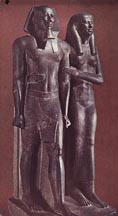Art Home | ARTH Courses | ARTH 200 Assignments
The Body in Egyptian Art
The image above is a statue of King Cephren or Khafre, the second of the three Pharaohs responsible for the Great Pyramids of Gizeh. It is made of diorite and is about 5 1/2 feet tall. It is dated approximately 2500 BCE which is in the middle of the Fourth Dynasty. It can be used to exemplify the treatment of the free-standing figure in Egyptian art. As we saw in our discussion of our opening comparisons, the function of a work is crucial in determining the form of the work. This is equally important here. The statue of Khafre is what the Egyptians call a ka statue. The work was made for the funerary complex of King Khafre. The Egyptians believed in the after-life. After the death of the physical body a part of the human continues to live. This is the ka which is understood as the life-force of the human. In death the ka needs a body to reside in. This necessity leads to the Egyptian practice of mummification as well as the abundance of sculptural representations. When we look at the statue of Khafre we should not understand it in our notion of a representation of a human figure. When we look at a statue of George Washington, we never confuse the statue as George Washington. It is a representation of George Washington. We see it as a sign for the signified. For the Egyptian, however, the ka statue of Khafre was a habitation for the ka of Khafre. When we look at the statue we are magically looking at Khafre himself. This is an eternal image of Khafre.
In your journals, consider how this function of the statue has influenced the form of the statue. Also consider the gallery of Egyptian figures below and define what you see as essential similarities of these Egyptian figures. In considering this, ask yourself what the artists show and don't show. Ask yourself also whether you consider these works to be successful portraits of the figures.






